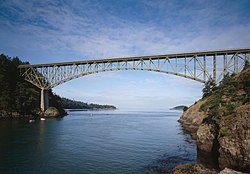Just north of Oak Harbor on Whidbey Island is the pass, very scenic and crazy water to ride. Anyone ever wants to check this out let the NW crew know and we will take you there. (video coming)
Deception Pass Bridge
From Wikipedia, the free encyclopedia
Jump to: navigation, search
Deception Pass BridgeU.S. National Register of Historic Places
Deception Pass Bridge, connecting Whidbey Island to Pass Island.
Location:SR 20
Island and Skagit counties, Washington
 United StatesNearest city:Oak Harbor AnacortesCoordinates:
United StatesNearest city:Oak Harbor AnacortesCoordinates:
 48°24′22″N 122°38′41″W / 48.40611°N 122.64472°W / 48.40611; -122.64472Built/Founded:1934-35Governing body:Washington State Department of TransportationMPS:Historic Bridges/Tunnels in Washington State TRAdded to NRHP:July 16, 1982NRHP Reference#:82004285
48°24′22″N 122°38′41″W / 48.40611°N 122.64472°W / 48.40611; -122.64472Built/Founded:1934-35Governing body:Washington State Department of TransportationMPS:Historic Bridges/Tunnels in Washington State TRAdded to NRHP:July 16, 1982NRHP Reference#:82004285


Both Canoe Pass and Deception Pass Bridges, looking east


View from Skagit County, looking south


Aerial view
The Deception Pass Bridge is a two-lane bridge connecting Whidbey Island to Fidalgo Island in the U.S. state of Washington. It was a Public Works Administration project built by young workers from the Civilian Conservation Corps. Completion of the bridge allowed the United States Navy to build Naval Air Station Whidbey Island and helped Oak Harbor, Washington flourish. The bridge is a commonly-photographed landmark of the Puget Sound region.
[edit] History
In the spring of 1792, Joseph Whidbey, master of HMS Discovery and Captain Vancouver's chief navigator, sailed through the narrow passage that is now called Deception Pass and proved that it was not really a small bay as charted by the Spaniards (hence the name "Deception"), but a deep and turbulent channel that connects the Strait of Juan de Fuca with the Saratoga Passage, which separates the mainland from what they believed was a peninsula (actually Fidalgo Island and Whidbey Island).
In the early years of the 20th century, travelers of the horse-and-buggy era used an unscheduled ferry to cross from Fidalgo Island to Whidbey Island. To call the ferry, they banged a saw with a mallet and then sat back to wait.
The bridge, one of the scenic wonders of the Pacific Northwest, is actually two spans, one over Canoe Pass to the north, and another over Deception Pass to the south. Construction began in August 1934, and the completed bridge was dedicated at noon on July 31, 1935. The Wallace Bridge and Structural Co. of Seattle, Washington provided 460 tons of steel for the 511-foot Canoe Pass arch and 1130 tons for the 976-foot Deception Pass span. The cost of construction was $482,000.
In 1982, the bridge was listed in the National Register of Historic Places.
It cost more to paint the spans in 1983 than it did to build them in 1935. They were painted again in 1997.
[edit] Bridge Facts
Deception Pass Bridge
From Wikipedia, the free encyclopedia
Jump to: navigation, search
Deception Pass BridgeU.S. National Register of Historic Places

Deception Pass Bridge, connecting Whidbey Island to Pass Island.
Location:SR 20
Island and Skagit counties, Washington




Both Canoe Pass and Deception Pass Bridges, looking east


View from Skagit County, looking south


Aerial view
The Deception Pass Bridge is a two-lane bridge connecting Whidbey Island to Fidalgo Island in the U.S. state of Washington. It was a Public Works Administration project built by young workers from the Civilian Conservation Corps. Completion of the bridge allowed the United States Navy to build Naval Air Station Whidbey Island and helped Oak Harbor, Washington flourish. The bridge is a commonly-photographed landmark of the Puget Sound region.
[edit] History
In the spring of 1792, Joseph Whidbey, master of HMS Discovery and Captain Vancouver's chief navigator, sailed through the narrow passage that is now called Deception Pass and proved that it was not really a small bay as charted by the Spaniards (hence the name "Deception"), but a deep and turbulent channel that connects the Strait of Juan de Fuca with the Saratoga Passage, which separates the mainland from what they believed was a peninsula (actually Fidalgo Island and Whidbey Island).
In the early years of the 20th century, travelers of the horse-and-buggy era used an unscheduled ferry to cross from Fidalgo Island to Whidbey Island. To call the ferry, they banged a saw with a mallet and then sat back to wait.
The bridge, one of the scenic wonders of the Pacific Northwest, is actually two spans, one over Canoe Pass to the north, and another over Deception Pass to the south. Construction began in August 1934, and the completed bridge was dedicated at noon on July 31, 1935. The Wallace Bridge and Structural Co. of Seattle, Washington provided 460 tons of steel for the 511-foot Canoe Pass arch and 1130 tons for the 976-foot Deception Pass span. The cost of construction was $482,000.
In 1982, the bridge was listed in the National Register of Historic Places.
It cost more to paint the spans in 1983 than it did to build them in 1935. They were painted again in 1997.
[edit] Bridge Facts
- Height from water to roadway: about 180 feet, depending on the tide
- Roadway: two 11 foot lanes, one in each direction
- Sidewalks: 3 foot sidewalk on each side
- Width of bridge deck: 28 feet
- Total length: 1487 feet (more than a quarter mile)
- Canoe Pass: one 350-ft arch and three concrete T-beam approach spans
- Deception Pass: two 175-ft cantilever spans, one 200-ft suspended span, and four concrete T-beam approach spans
- Vehicle crossings: 20,000 per day, average
- Maximum speed of current in Deception Pass at flood/ebb tide: 9 kts
- Maximum speed of current in Canoe Pass at flood/ebb tide: 10 kts
